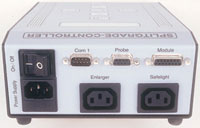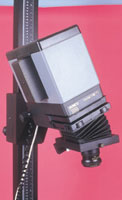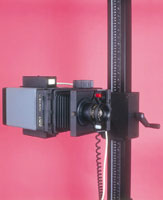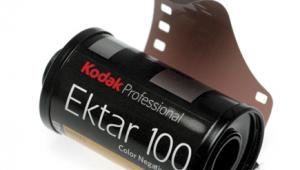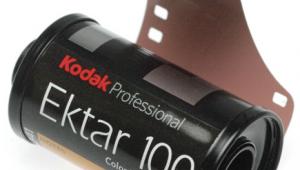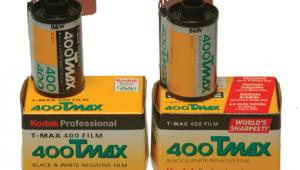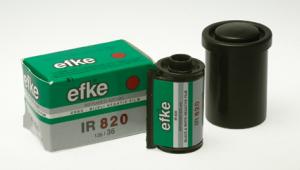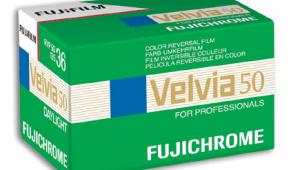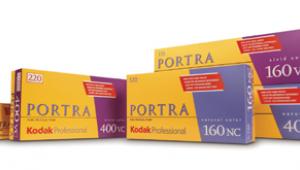Dunco Vario Split Enlarger
Dunco isn't exactly a household word among photographers on the west side of the Atlantic. My first exposure to the brand was at the 1994 photokina show in Ger-many, where I discovered their line of medium format enlargers and adjustable printing easels. I was pleased with the designs and quality, but disappointed by the fact that they were just one more European maker of excellent darkroom equipment with no distributor in North America. The easels would make a brief appearance here, before losing their distributor, but the enlarger line was never picked up. I'm happy to say that we can now avail ourselves of Dunco products, with the assignment of a new distributor for the US and Canada, Phomage, located in British Columbia. They were exhibiting at the February PMA show in Las Vegas, and I managed to stuff a demo model of their latest enlarger, the Dunco Vario Split, into the back of my two-seater car and lug it back to Los Angeles for a review. The Vario Split is a medium format model, for negatives up to 6x7cm. Configuration is classic European (German, to be exact), that is with a 90 (in relation to the baseboard) column. Regarding the column, trust me--rigidity is not an issue! Measuring 48" tall, 3" wide by 2" deep, it's definitely up to the job. A crank handle raises and lowers the counterbalanced head smoothly; elevation can be referenced by the inch and centimeter rulings on the column. Unlike many current enlargers, an elevation locking knob is provided, a simple feature appreciated by printers who frequently engage in multiple printing and collage work requiring many insertions/removals of the negative carrier. As with most enlargers, I wish the Vario Split had a larger baseboard, but the 19.5x23.5" one supplied, in conjunction with the tall column, permits a quite respectable 20x enlargement with a 50mm lens. Should you have an occasional need to make larger prints, tilting the enlarger head 90 for wall projection will get you an image as large as you're likely to want to attempt to process. |
|||
The large focusing knob is geared quite low, resulting in a somewhat slow, but very precise and smooth, backlash-free movement. You can remove the knob and replace it with a remote-focus cable, enabling you to reach the focus control when making big enlargements and using an on-easel critical focuser. The lens stage uses round lensboards, making it easy to align lens markings exactly as you wish for best visibility. A flat board accommodates lenses below 75mm focal length, an extended one serving for 75mm on up. The lens stage can be tilted, which in combination with the tilting head (that doubles as a tilting negative stage) can effectively deal with such perspective correction tasks as converging verticals. There are also a pair of knob-actuated filters built-in to the lens stage: the usual red one, plus a diffusion filter. |
|||
The negative carriers are book-type, but unlike most other European brand equivalents, are not "universal," e.g., accommodating multiple formats via interchangeable masks and movable film stop pins. Dunco makes separate carriers for each format: 35mm, 6x4.5cm, 6x6cm, and 6x7cm, each with four built-in masking blades. The 6x7cm carrier supplied for review was glass-type; the glass is not removable, but the upper glass is anti-Newton treated. Glassless carriers are available. The 35mm carrier supplied was glassless and of the "full frame" (25x37mm) variety. Except for a metal bottom plate that protects the masking blades, the carriers are mostly of polycarbonate construction, a material that possesses superior impact resistance (in case you drop the carrier) and self-lubricating qualities. The carriers latch magnetically, and will lock in a slightly open position for advancing strips of negatives without having to remove the carrier from the enlarger. |
|||
The illumination system consists of a double condenser set, combined with interchangeable light mixing boxes and a 12v/100w halogen lamp/cold mirror, for a semi-diffusion scheme. A 6x7cm mixing box is standard; the boxes for smaller formats will gain you some image brightness, mostly of value when making big blowups from dense 35mm negs. Dunco offers several interchangeable filter modules: a "C" module is for color printing; a "VC" module provides manually-set variable-contrast filtration; a "CVC" module is a unique universal set, usable with graded and VC black and white papers, as well as all color papers. The Vario Split incorporates its own "VS" module, with motor-driven filters for variable-contrast printing in Grades 00 to 5, controlled from a baseboard analyzer/timer. This baseboard controller is the Vario Split's electronic brain, and the facility that makes this enlarger appealing to high-tech buffs. Though Dunco touts this enlarger as a boon for novices, it is the experienced darkroom worker who will be able to extract the maximum benefit from the high degree of precise control this unit makes possible. |
|||
Anyone who has to turn out a lot of prints in minimal time, possibly from the negatives of many different photographers, will save a lot of time and wasted materials with the Vario Split. Rather than having to guess at the proper contrast and exposure time for unfamiliar negatives, the printer uses the on-easel measuring probe to analyze the projected image. By reading the densest areas of the negative (ignoring specular highlights) and the thinnest shadow areas (that still contain detail), the control unit will determine, and automatically set the proper filtration for the required degree of contrast; it deduces and sets the exposure from these same readings. An audible signal each second can be switched off. High or low-key scenes are best accommodated by spot readings (the probe has a 3mm aperture). With the filter module disconnected, the controller serves as a black and white analyzer and meter. |
|||
Contrast is controllable in as fine as 1/10 grades. An even greater degree of repeatability is assured, thanks to a voltage-stabilized power supply, and a shutter that begins the exposure only after the enlarger lamp is at full intensity, and ends the exposure an instant before the lamp is extinguished, avoiding "afterglow" exposure. The controller can analyze a 10 f/stop density range. Timing is from 1-200 sec, in 0.1 sec increments; repeatability is 0.1 percent. The time base reference can be changed to 1/10 f/stops, an easier frame of density value reference with longer exposures. Should you be distracted by a phone call while focusing, the lamp will turn off automatically after five minutes. The unit features an illuminated (adjustable intensity) LCD display, showing four lines of data. The touch-pad control buttons consist of left and right arrows for moving the display's cursor to select or modify data; plus (+) and minus (-) buttons increase or decrease the value selected with the cursor, or change functions; a "focus" button turns the enlarger lamp on for focusing and analyzing the negative with the probe; a "start/stop" button initiates set exposure time (pushing button during timing sequence suspends exposure; pushing again resumes sequence; pushing any other button cancels set time); "page" cycles through the various LCD displays. If light intensity or set time are out of range in either direction, an error report appears. Data can be displayed in English, German, or Japanese. |
|||
The controller is factory programmed for Agfa, Forte, Ilford, Kodak, and Tetenal variable contrast papers, as well as five film types (all silver halide films, plus four chromogenic black and white films; base color and plus, minus, or normal exposure, which affect contrast, are the relevant factors with the chromogenic films). White light printing with graded black and white papers is also possible. For future VC papers, or to modify existing programs, there's an RS232 computer port on the back of the controller. The filter module employs a two-exposure, "split-filtration" technique with separate exposures through pure magenta and pure yellow filtration (magenta/yellow or yellow/magenta sequence is selectable). With the audible signal switched on, there's a long note just before the filter change. Many fine art printers feel that this method produces a superior tonal range on premium VC papers, and is also an effective burning procedure. |
|||
Included for review with the Vario Split was a Dunco 90/4 Prof enlarging easel. Accommodating prints up to 12x16", it is as nice an adjustable-blade easel as I've seen. Each of the four blades is individually adjustable, a big plus when you want unequal borders top and bottom. The blades move very smoothly via large knobs, with no herky-jerky "chatter." If the blades should ever get out of alignment, they can be trued. There are four horizontal slots to anchor various sizes of paper; two movable blocks in each slot prevent choosing the wrong slot in the dark. The welded steel top frame stays open for both hands-free paper loading, thanks to a piston arm. Rubber strips on the bottom, plus substantial weight, assure that the easel will stay put. The legible, white-on-black rulings are self-centering, zeroing from opposite directions side to side and top to bottom. Nice easel! |
|||
My overall impressions of the Dunco Vario Split are quite favorable. Construction is mostly die-cast aluminum and stamped steel. The minor changes I'd like to see, other than my usual plea for larger baseboards, are more positive zero detents for the tilting head and lens stage, and an added coarse focus facility (to speed things up when switching from 35mm to medium format negs). Other than that, the only hitches were the almost inevitable ones experienced when a company initially tackles a foreign market: sketchy "interim" manuals, and electrical cords ending in mysterious European fittings. A fistful of adapters eventually gets you up and running, but North American-friendly plugs and connectors are hopefully in the works. The bottom line: this enlarger's claim to fame is speed and precise repeatability, and once you gain familiarity with the controller, your precious darkroom time can be considerably more productive. The Dunco Vario Split (consisting of the enlarger chassis, XL column, baseboard, lamp house, VS filter module, controller, probe, foot switch, and connecting cords) has a street price of $3749. For more information, contact Phomage, 505-8840 210th St., Box 345, Langley, BC V1M 2Y2, Canada; phone/fax: (604) 888-7035; www.phomage.com. |
- Log in or register to post comments

